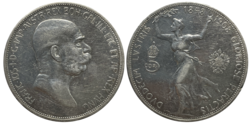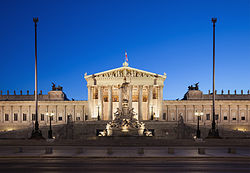Austria-Hungary
Coordinates: 48°12′N 16°21′E / 48.200°N 16.350°E
Austria-Hungary or the Austro-Hungarian Empire was a state in Central Europe from 1867 to 1918.[5] It was the countries of Austria and Hungary ruled by a single monarch. This also included the Kingdom of Croatia-Slavonia as a constituent kingdom. The full name of the empire was "The Kingdoms and Lands Represented in the Imperial Council and the Lands of the Crown of St. Stephen".
Austro-Hungarian Empire | |
|---|---|
| 1867–1918 | |
| 'Motto: | |
| Anthem: | |
| ' | |
 Austria-Hungary on the eve of World War I | |
| Capital | Vienna (Cisleithania) Budapest (Transleithania) |
| Official languages |
Other spoken languages: Bosnian, Czech, Romani (Carpathian), Italian, Istro-Romanian, Romanian, Rusyn, Ruthenian, Serbian, Slovak, Slovene, Yiddish[2] |
| Religion | 76.6% Catholic (incl. 64–66% Roman Catholic & 10–12% Eastern) 8.9% Protestant (Lutheran, Reformed, Unitarian) 8.7% Orthodox 4.4% Jewish 1.3% Muslim (1910 census[3]) |
| Demonym(s) | Austro-Hungarian |
| Government | Constitutional dual monarchy |
| Emperor-King | |
• 1867–1916 | Franz Joseph I |
• 1916–1918 | Karl I & IV |
| Minister-President of Austria | |
• 1867 (first) | F. F. von Beust |
• 1918 (last) | Heinrich Lammasch |
| Prime Minister of Hungary | |
• 1867–1871 (first) | Gyula Andrássy |
• 1918 (last) | János Hadik |
| Legislature | 2 national legislatures |
• Imperial Council | Herrenhaus Abgeordnetenhaus |
• Diet of Hungary | House of Magnates House of Representatives |
| Historical era | New Imperialism • World War I |
• | 30 March 1867 |
• Dual Alliance | 7 October 1879 |
• Bosnian Crisis | 6 October 1908 |
| 28 June 1914 | |
| 28 July 1914 | |
• Aster Revolution | 31 October 1918 |
| 12 November 1918 | |
• Hungarian Republic | 16 November 1918 |
| 10 September 1919 | |
| 4 June 1920 | |
| Area | |
| 1905[4] | 621,537.58 km2 (239,977.00 sq mi) |
| Population | |
• 1914 | 52,800,000 |
| Currency | |
The dual monarchy replaced the Austrian Empire (1804–1867). It started with the compromise between the ruling Habsburg dynasty and the Hungarians. It was an empire made up of many different ethnic groups and was a great power. It found its political life full of arguments between the eleven main national groups. It had great economic growth through the age of industrialization. It also saw social changes with many liberal and democratic reforms.
The Habsburg dynasty ruled as emperors of Austria over the western and northern half of the country and as kings of Hungary over the Kingdom of Hungary. The Kingdom of Hungary had some ability to govern itself. It also had a say in things that affected both it and the rest of the empire. This was mainly foreign relations and defense.
The empire had two capital cities: Vienna in Austria and Budapest in Hungary. Austria-Hungary was the second largest country in Europe (after the Russian Empire). It had the third most people (after Russia and the German Empire).
Creation of Austria–Hungary
The Ausgleich or compromise of February 1867 created the Empire's dualist structure. The Austrian Empire (1804–67) had lessened in strength and in power. This was because of the Austro–Sardinian War of 1859 and the Austro–Prussian War of 1866. Also, the Hungarian people were not happy with how Vienna treated them. This had been going on for many years and it led to Hungarian separation. This included the Hungarian liberal revolution of 1848–49.
Emperor Franz Joseph tried to reach an agreement with the Hungarian nobility. He needed their support to keep the empire together. The Hungarian nobility would not accept anything less than equality between themselves and the Austrian elites.
Governmental structure
Hungary and Austria had different parliaments. Each had its own prime minister. The monarch kept the two working together. He had absolute power in theory but very little in reality. The monarch’s central government had charge of foreign policy, the customs union and the armed forces. The empire had a navy and three armies: an Austrian army, a Hungarian army, and the larger "common" army.
World War I
The deaths of Franz Joseph's brother, Maximilian I of Mexico (1867), and his only son, Crown Prince Rudolf, made the Emperor's nephew, Franz Ferdinand, next in line to the crown. On 28 June, 1914, the heir visited the Bosnian capital, Sarajevo. Bosnian Serb militants of the group Mlada Bosna attacked Franz Ferdinand's motorcade and assassinated him.
Some members of the government, such as Conrad von Hötzendorf had wanted to fight the Serbian nation for many years. The leaders of Austria-Hungary decided to attack Serbia before it could start a revolt. They used the assassination as an excuse. They gave Serbia a list of ten demands called the July Ultimatum.[6] They expected Serbia would not accept. Serbia accepted nine of the ten demands but only partially accepted the other one. Austria-Hungary declared war.
These events brought the Empire into conflict with Serbia. Russia moved its army to help Serbia. This set off troop movements on both sides and started World War I.
End of the Empire
By 1918, it was obvious that the Allied powers would win. Nations began declaring their independence from Austria-Hungary as the government of the empire began to collapse. The following nations were created from the territories of Austria-Hungary:
Some nations only got part of their lands from the Empire. These include:
- The Kingdom of the Serbs, Croats, and Slovenes (gained most of their territory from Austria-Hungary but also had Serbia and Montenegro)
- Poland (minor territories near modern day Slovakia and the Czech Republic)
Some Austro-Hungarian lands were also given to Romania and Italy.
Austria-Hungary Media
Recording from the 1910's.
Silver coin: 5 corona, 1908 – the bust of Franz Joseph I facing right surrounded by the abbreviated legend "FRANC[iscus] IOS[ephus] I, D[ei] G[ratia], IMP[erator] AUSTR[iae], REX BOH[emiae], GAL[iciae], ILL[yriae], ETC, ET AP[ostolicus] REX HUNG[ariae]"
Coronation of Francis Joseph I and Elisabeth Amalie at Matthias Church, Buda, 8 June 1867
Meyers Konversations-Lexikon ethnographic map of Austria-Hungary, 1885
Topographic map of Austria-Hungary in 1914
References
- ↑ Fisher, Gilman. The Essentials of Geography for School Year 1888–1889, p. 47. New England Publishing Company (Boston), 1888. Retrieved 20 August 2014.
- ↑ From the Encyclopædia Britannica (1878), although note that this "Romani" refers to the language of those described by the EB as "Gypsies"; the EB's "Romani or Wallachian" refers to what is today known as Romanian; Rusyn and Ukrainian correspond to dialects of what the EB refers to as "Ruthenian"; and Yiddish was the common language of the Austrian Jews, although Hebrew was also known by many.
- ↑ Geographischer Atlas zur Vaterlandskunde, 1911, Tabelle 3.
- ↑ Encyclopaedia Britannica, 11th Edition, "Austria, Lower" to "Bacon" Volume 3, Part 1, Slice 1. Archived from the original on 12 January 2019. Retrieved 12 January 2019.
- ↑ Michael L. Miller. "Austro-Hungarian Empire, 1867-1918". Oxford Bibliographies. Oxford University Press. Retrieved 18 June 2016.
- ↑ "First World War.com - Primary Documents - Austrian Ultimatum to Serbia, 23 July 1914". firstworldwar.com. 2011. Retrieved 22 July 2012.
Other websites
- "Distribution of Races in Austria–Hungary" from the Historical Atlas by William R. Shepherd, 1911
- The Austro-Hungarian Military
- Austria–Hungary - extensive list of heads of state, ministers, and ambassadors
- Austria-Hungary, Dual Monarchy
- History of Austro-Hungarian currency
- Ausgleich -Citizendium








